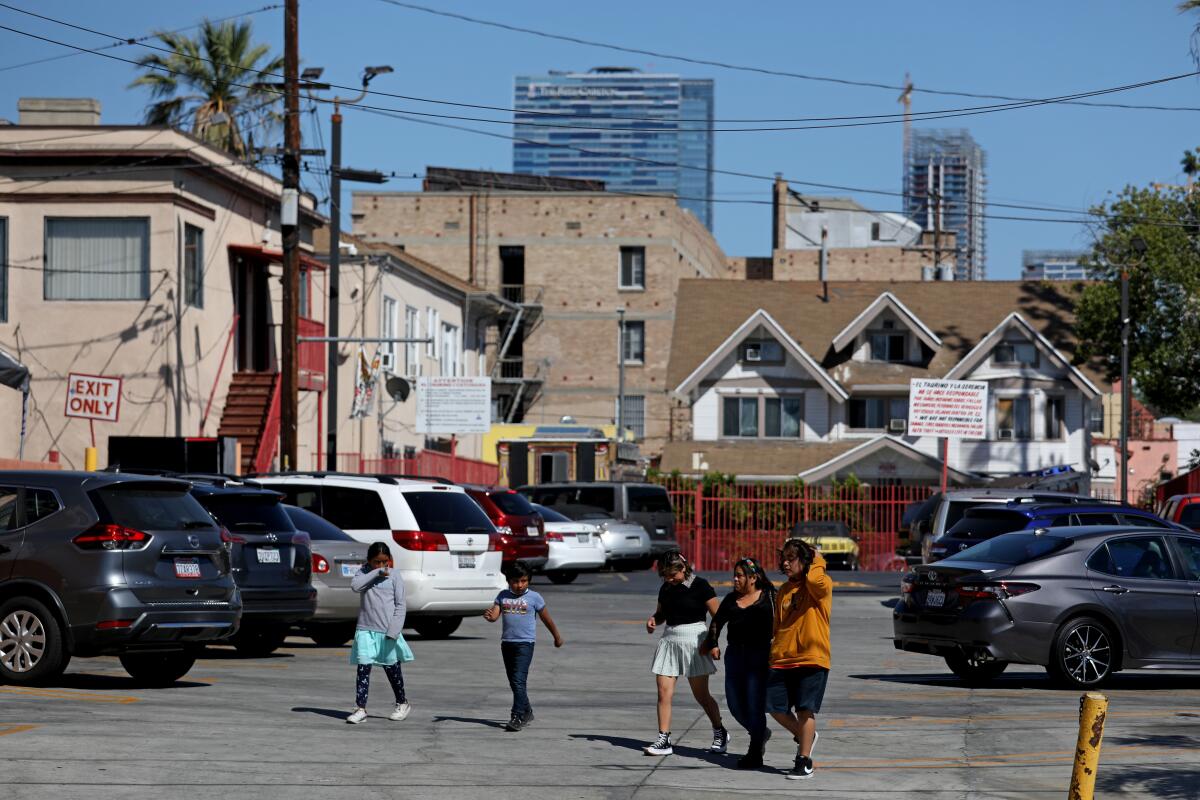Letters to the Editor: Landlords sparked L.A.’s overcrowding crisis. They got an assist from leaders

To the editor: As an L.A. County social worker in the 1970s, I had a caseload at any given time of 60 clients recently released from state mental institutions into Los Angeles. The areas I served included skid row, downtown L.A., Westlake-MacArthur Park and Pico-Union. My clients stayed housed because rents for studios and one-bedroom apartments were affordable. Nobody chose to live on the streets. (“L.A.’s love of sprawl made it America’s most overcrowded place. Poor people pay a deadly price,” Oct. 19)
By 1980, landlords discovered that they could charge families more than individual tenants. The loss of single-room occupancy units aggravated the problem.
As rents continued to increase throughout L.A. County, homeless individuals and families began spilling onto the streets, resulting in the intractable humanitarian crisis we are experiencing today.
Rather than fight for more decent and affordable rental housing for everyone, local leadership has instead allowed faulty government policies to take control. The negative physical, developmental and emotional impacts of overcrowding, substandard housing and homelessness are well-documented.
This is not rocket science. Shame on us for not fixing the problem by now.
Tanya Tull, Los Angeles
The writer founded the groups Para Los Niños, A Community of Friends and Beyond Shelter.
..
To the editor: Your report on overcrowding is an honest and timely view of housing in Los Angeles. It points out why our homeless count continues to increase.
The favored approach for helping homeless individuals and families is “housing first,” which dictates placement in permanent housing prior to receiving services. The problem with this approach is that there is virtually no housing.
The Housing Authority of the city of Los Angeles places about 5% of those who apply for federal Section 8 assistance in permanent housing. Recently, The Times reported that local agencies returned nearly $150 million in unspent funds meant for housing homeless people to the federal government.
Another issue is that many of the families and individuals living in those crowded conditions qualify under the definition of the federal Housing and Urban Development Department as being homeless. This would increase our homeless count by a substantial amount. You could refer to them as our invisible homeless.
I have lived in the Los Angeles area for more than 65 years, worked in homeless services for more than 30 years and watched this problem develop and increase over these years. There is no easy solution, but I believe an honest appraisal of the problem and our failed approaches would be a good start.
Jim Howat, Long Beach
..
To the editor: The photograph of the badly overcrowded Pico-Union neighborhood with downtown’s shiny Ritz-Carlton hotel in the background presents a definite irony.
The city has handed many millions in tax subsidies to developers of these upscale hotels, while just a few blocks away working people struggle with some of the city’s worst housing conditions. If ever a picture offered the city a reason to reorder its priorities, this would be it.
Dennis Hathaway, Venice
..
To the editor: Our family home was and still is in the Pico-Union area. When we were in school in the 1930s and 40s, our classmates and neighbors were white, and we were Filipino Americans.
As The Times describes, the area is now overcrowded and inhabited largely by immigrants from Mexico and Central America. The living conditions that are conducive to the spread of COVID-19 are sad but unavoidable.
Mayoral candidates Rick Caruso and Karen Bass have discussed homelessness extensively, but I have not seen proposals for addressing overcrowded areas like Pico-Union in their plans to alleviate the need for affordable housing. How do Caruso and Bass intend to solve another housing crisis in our city?
Lenore Navarro Dowling, Los Angeles
..
To the editor: I noticed the term “white spot,” used by early 20th century boosters of Los Angeles, referenced in your article. Here is what I found about that term in researching my book, “The Long Winding Road of Harry Raymond.”
The term “white spot” was imported from grayscale business activity maps published by the National Chamber of Commerce, which depicted areas experiencing poor (solid black), fair (dark gray) or good (light gray) business conditions.
In March 1921, one such map showed Los Angeles as the only area in the nation where business activity was not “at a standstill.” The Los Angeles Times seized on the image, utilizing it in a publicity campaign for the region. A few years later, it had a new slogan: “Keep the white spot white,” and eventually the term expanded to imply not just excellent business conditions, but moral and spiritual values.
Many other areas and cities across the nation embraced the term to describe their business prosperity in years to come. While later writers suggested the term had racial undertones, no such allusion was made in the days when the “white spot” metaphor was popular.
Patrick Jenning, Rancho Mirage
..
To the editor: The Times published more than 5,000 words about overcrowding in L.A., and not one was about the nearly 1 million people in this county who are in the country illegally. Regardless of one’s belief of whether those people should be allowed to stay, it is their presence that is the main reason that L.A. is America’s most overcrowded place.
This was an excellent article detailing the racism and terrible policies that negatively impacted so many people over the past century, but it was disingenuous at best to fail to acknowledge the impact that illegal immigration has had on overcrowding.
The authors likely knew this was the case with their statement, “More homes are overcrowded in Los Angeles than in any other large U.S. county, a Times analysis of census data found — a situation that has endured for three decades, with no sign of abating.”
Until now, those three decades saw the highest number of people illegally entering the country ever.
Don Rosenberg, Westlake Village






